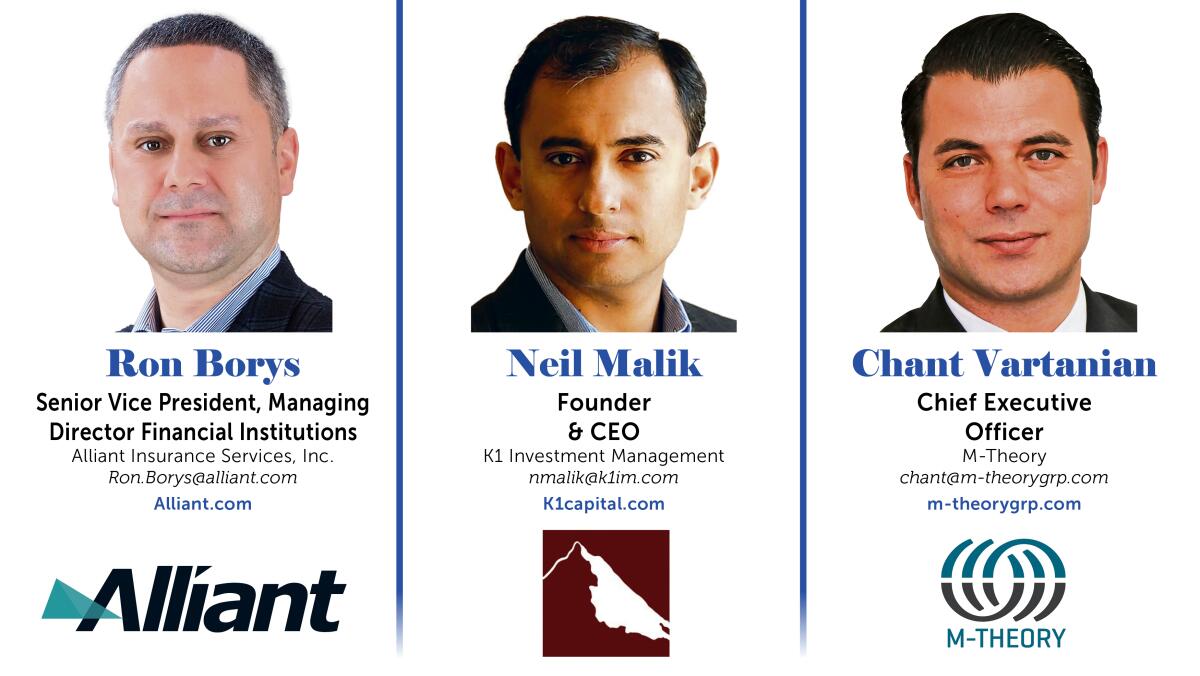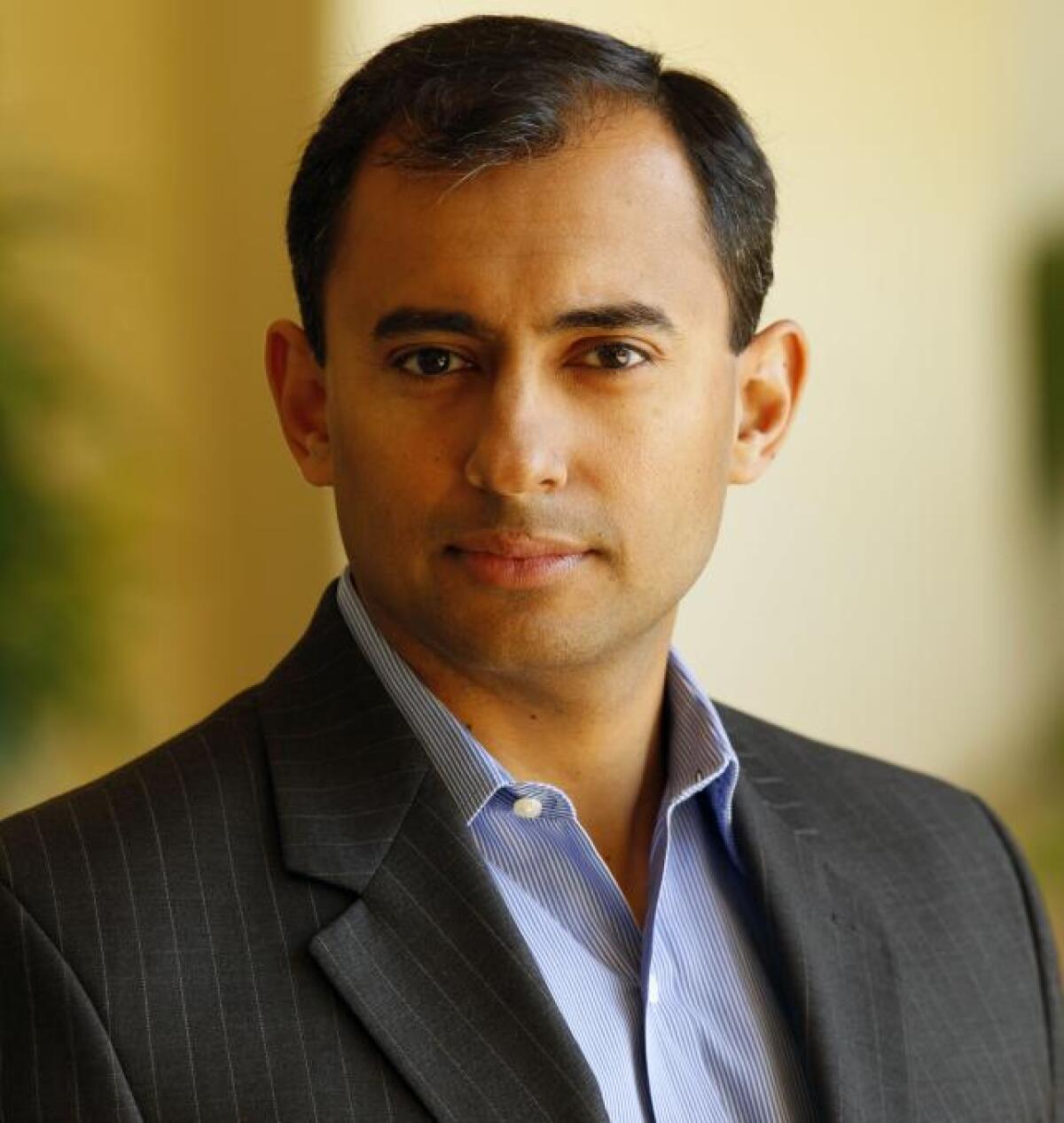Ron Borys, Neil Malik and Chant Vartanian Give Insights on the Outlook of Private Equity

The Private Equity Outlook panel is produced by the L.A. Times B2B Publishing team in conjunction with Alliant Insurance Services, Inc.; K1 Investment Management; and M-Theory.
Due to the wildly unpredictable circumstances and factors affecting the world of finance over the last couple of years, a number of new strategies and projections have emerged in terms of managing and attracting private equity. The economic climate has also pushed companies to make changes to the way they do business and to the way they approach their fiscal needs.
To address these issues and uncover the latest trends in the handling of private equity from both sides of the table, the Los Angeles Times B2B Publishing team turned to three uniquely knowledgeable professionals for their thoughts and insights about the most important “need-to-know” insights and to get their assessments regarding the various trends that they have been observing.
Q: What are some of the most interesting and/or meaningful trends you have seen in private equity over the last couple years?

Ron Borys, Senior Vice President, Managing Director Financial Institutions, Alliant Insurance Services, Inc.: During a time of low interest rates and recovery in credit markets, one of the more meaningful trends we’ve noticed over the last couple of years has been how private equity firms have been able to negotiate favorable terms, such as portability clauses into loan documentation on deals. This has helped further fuel the M&A and refinancing boom because existing lenders aren’t able to change terms at time of a sale or a refinancing.

Neil Malik, Founder & CEO, K1 Investment Management: Recently the time interval between fundraises has shrunk while fund sizes have grown significantly. This year 15 large PE managers are each seeking to raise over $15 billion each. This accounts for over 60% of the capital that will be raised in 2022. Investor limited partners are making difficult decisions to ration that capital to existing managers. This situation is accentuated by the fall off in the public equities portfolio, creating a negative denominator effect leaving LPs overallocated to private equity. This will also likely impact capital available for all the other managers in the industry. One mitigating factor may be the increasing source of funding from retail investors. Retail may become a much more significant source of capital for private equity.
Q: Why have SPACs become so popular?

Chant Vartanian, Chief Executive Officer, M-Theory: SPACs enjoy wide appeal. Investors can gain early access to an investment vehicle normally reserved for the wealthy elite. It has been dubbed the “poor man’s private equity fund” for good reason. The market saw explosive year-over-year growth starting in 2020. Less regulation and oversight (as compared to a traditional IPO) means this can be a far easier option for ambitious new founders and seasoned Wall Street types alike. With “easy” comes greatly increased risk. To some, this is just a reboot of the 1980s “blank check company.” Rampant fraud plagued that model, and SPACs live in that shadow today. Despite the risks, there is no denying the wide appeal and we don’t see this trend stopping anytime soon. Barring additional government oversight, it will remain an attractive option for many — from trendy celebrities with a hot product to traditional corporations looking to avoid the overhead and resource drain that an additional IPO may bring.
Borys: The prevalence of SPAC IPOs and business combinations has exploded in recent years, with SPACs raising more than $83 billion in IPOs in 2020 and more than $160 billion in 2021 IPOs. SPACs are a funding vehicle that has offered target companies specific advantages to traditional initial public offerings (“IPOs”). SPACs have historically provided target companies with advantages such as less dilution upon going public (i.e., more control for owners of the target company), quicker access to capital (shorter time frame to complete the IPO), certainty in valuations (SPAC and target companies agree on value ahead of IPO) and a lower IPO cost structure. There are currently more than 600 SPACs searching to complete a business combination with a target company through a de-SPAC transaction.
Q: How significant a trend is ESG reporting in terms of private equity?
Malik: What initially began with a policy statement requirement from European investors has become a more global focus from investors on ESG. While there are a number of companies projecting carbon neutrality at some future date, there are few standardized metrics to uniformly report on the success of these initiatives now. We are proud to have over 60% of K1 employees driving electric vehicles, renewably generating most of our own power for office consumption and the majority of our new hires this year representing women in all of our departments. And further, in an effort to drive greater social mobility, we are proud that about 25% of our employees are first-generation college graduates. Over the past couple years, there has also been a more focused interest to see improvements in diversity. This includes diversity within private equity firms but also diversity in the management teams and boards of portfolio companies. Investors are more keen to see front office diversity, not just at the firm-wide level via support or back-office functions.
“This time last year, headlines read: ‘Inflation is transitory.’ Was that ever actually true? What did it portend? In retrospect, it is plainly obvious that even the Fed knew it was not true.”
— Chant Vartanian
Q: What type of information do prospective investors ask for today as part of due diligence that they didn’t ask for, say, five years ago?
Malik: More prospective investors are actively seeking to deploy a growing part of their capital as co-investors. They also want to play an increasingly important role in underwriting decisions and governance. We are seeing many large take-private deals where the private equity firm is putting up a minority of the capital to consummate these deals and syndicating the balance to co-investors.
Q: As we move deeper into 2022, what are the private equity hot button issues and warning signs to be aware of?
Borys: Hot button issues that could continue to impact deal-making include heightened inflation, geopolitical risks and tougher governmental regulation, especially in the United States. Additionally, higher interest rates could have an impact on already over-leveraged portfolio companies and their ability to fund business operations while also paying down debt obligations.
Malik: Last year IPOs, SPACs and late-stage venture rounds were completed at lofty valuations. There have been widespread and significant impairments. Distributions and liquidity events may also be significantly lower than last year. These dynamics could lead to more take private opportunities as well as a shift to a value-oriented investing style. Operating companies will be under greater pressure to demonstrate greater profitability.
Q: What industries and business categories seem most attractive to investors right now?
Malik: Predictability of operating performance is a key element given the market volatility. Businesses that are suffering from supply chain hiccups, raw material shortages, energy shocks and labor shortages are just a few of the difficult aspects of our economy. Businesses that have asset-light, highly scalable and recurring revenue business models remain popular among investors. Last year about one-third of private equity-backed deals were in the technology arena. At K1, we specialize in B2B enterprise software investing and have continued to see resilience in this sector over the past decade and even within the past two years. We remain convinced that enterprise software continues to be one of the most attractive sectors for investors given the contractual revenue and overall market resilience. Our experience has shown us that even during a market downturn, enterprises and institutions of all shapes and sizes need to find solutions that help them adapt and automate processes in order to run their business more efficiently when resources are restricted.
Q: What important parts of a deal are commonly overlooked?
Malik: It’s relatively straightforward to assess the fundamentals of an investment. The motivations of sellers may include a desire to attract growth capital, monetize gains or potentially consolidate their industry. However, it’s quite important and difficult to ascertain the cohesiveness of leadership teams. Is it a team that complements each other in a candid and accountable manner or is it a group that simply takes orders in more of a chain of command model? Teams that exhibit greater elements of trust and diversity should be better able to handle challenges and surprises that will inevitably come their way.
Q: What is the explanation for the wide-ranging difference in stock price performance in post-merger SPACs?
Vartanian: Poor fundamentals often explain disappointing post-merger stock prices. For instance, many companies are often pre-revenue with no hope of near-future profitability. We know the market has no appetite for yet another company with a great idea and flawed business mechanics. Another big difference is the mix of retail versus institutional investors. With ordinary IPOs, institutional investors are front-of- line, and with SPACs retail investors color the investment demographics. Finally, and maybe most damning, is the inherent dilution factors that saddle all SPAC post-merger deals. The biggest is that SPAC sponsors compensate themselves with a guaranteed 20% post-IPO equity stake. When a SPAC merges, a stock price of $10 is set. In short, median dilution (plus underwriting fees) means that in a $10 price, only $6.67 is cash — and $3.33 is dilution! SPACs simply do not have $10 cash for each outstanding share. Unless there is something else truly unique at play, market forces are stacked against SPAC mergers. Many pundits signal the end of SPACs for this reason.
“While there are a number of companies projecting carbon neutrality at some future date, there are few standardized metrics to uniformly report on the success of these initiatives now.”
— Neil Malik
Q: What changes can we expect in the SPAC market and the basic structure of a SPAC?
Borys: The Securities and Exchange Commission (SEC) has been vocal in recent months about the structure and “advantages” of SPACs for investors. The SEC has proposed new rules and amendments regarding IPOs by SPACs and de-SPACs. If adopted, the proposed new rules will have a significant impact on SPACs throughout their life cycle, with particular focus on disclosures both for SPAC IPO and de-SPAC transactions. The proposed rules also address the issue of whether SPACs should be considered “investment companies” under the Investment Company Act of 1940, which has been a hotly contested topic since the significant uptick in SPAC IPOs beginning in 2020. The proposed rules are subject to an open public comment period that runs through at least the end of May. Until the proposed rules and amendments are adopted, it is difficult to predict what the future may hold for the SPAC market and the structure of a SPAC. As a result of the SEC’s comments and proposed rules for SPACs and de- SPACs, investor interest has already cooled significantly in 2022.
Q: If the SEC begins to require enhanced disclosure regarding projections in the proxy statement/prospectus for the de-SPAC transaction, will deals change?
Vartanian: To answer this question, we should first examine why this mechanism is used. A SPAC is used to merge with an acquisition target company. Naturally, it is mostly used for mergers and acquisitions. This is also seen with struggling businesses in the form of a reorganization. Part of the wide appeal is less involvement from the SEC. Anything that starts to resemble such oversight will rob the shine from this type of engagement. The last thing anyone involved with such a merger wants is to return investor funds - with interest! A big part of the de-SPAC appeal is timing. Once official investor voting has happened, the process can be complete in no more than six months. More SEC involvement would likely manifest in additional time overhead.
Q: What should CEOs and other executives of growing companies be aware of regarding the culture and style of private equity firms?
Malik: Management teams and executives can look at private equity firms through a variety of lenses. Are decision-makers entrepreneurs themselves or the second or third generation to inherit the mantle? Are decisions made and empowered at the deal team level or are they required to seek a more senior level of approval from inside the firm? Strategies and tactics to earn returns will likely evolve and change but are there any fundamental values that the private equity firm holds sacred? How authentic are the interactions with dealmakers? Do they appear to be genuinely happy, coming to the office and likely to remain at the firm during the entire partnership with the company? The loss of executive sponsorship can be problematic.
“SPACs have historically provided target companies with advantages such as less dilution upon going public, quicker access to capital, certainty in valuations and a lower IPO cost structure.”
— Ron Borys
Q: What’s keeping dealmakers up at night in 2022?
Vartanian: This time last year, headlines read: “Inflation is transitory.” Was that ever actually true? What did it portend? In retrospect, it is plainly obvious that even the Fed knew it was not true. Beyond inflation, we are facing a host of unique macro-economic climate changes. Yes, the same pandemic conditions that brought us these inflationary pressures persist ... but now we see entirely new global market changes as dictated by the Russian invasion of Ukraine. Enormous infrastructure investments have effectively been abandoned, and it is clear the Russian market will be toxic for western investors for many years. Meanwhile, China is keeping a close eye on the Russian effort. Will Chinese aggression result in a similar invasion of Taiwan? What disastrous outcomes await that action? Back on domestic ground, the lending apparatus is drying up. Higher rates, a spooked and bearish market, and investor skepticism mean we are looking at a very different landscape now. We have plenty to worry about it seems.
Malik: Rising interest rates, falling valuation multiples, energy shocks, supply chain disruptions, increasing wage pressures, inflation and the reversal of quantitative easing are just a few things keeping up dealmakers! SPAC and IPO activity has come to a temporary halt.